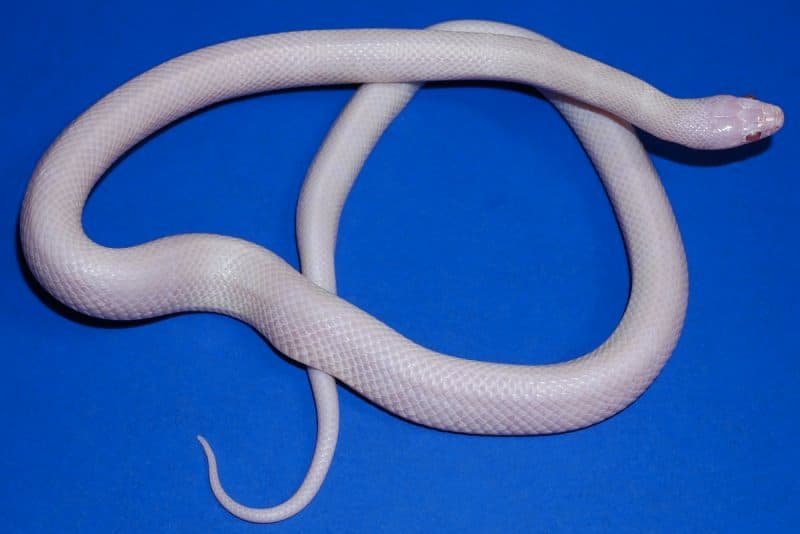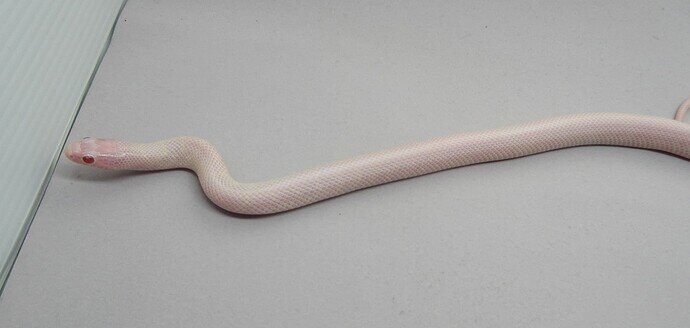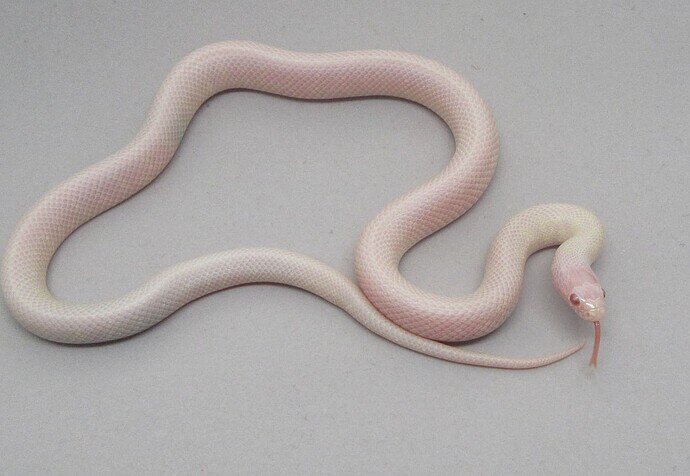I recently saw what are being labeled as albino Mexican Black Kingsnakes on the marketplace. While I’m familiar with the brown T-pos morph in MBKs, I hadn’t ever heard of any other MBK morphs. I was under the impression that T-pos albino was the only pure MBK morph. This albino morph I just saw on the marketplace appears to be a stark white, resembling a T-neg albino. Is this a true MBK morph? Are there any other MBK morphs out there?
Considering the breeder also produces Albino Cali kings, I suspect it’s an intergrade, especially because on some of the animals, you can see banding that suggests such. For example, look at the neck banding on this animal:
This was my first suspicion but wanted to ask around here since it was not explicitly noted that this was a hybrid animal and the asking price is quite steep for a simple cross. I was hopeful that these animals were true MBKs and just a morph I was unfamiliar with as mislabeling is quite the shady practice which reflects poorly on the hobby. And if it is indeed a cross to try to get the morph within the MBK species, like we’ve seen with many morphs shared between North American colubrids, in my mind this should be disclosed and the price should reflect that of a cross.
I went digging via Google and as far as I can tell, no one has ever publicly acknowledged producing a T- albino MBK, and the specific breeder has never come on this forum to ask to have the morph added. Considering how protective people are of new morphs, and how much of a status symbol it is to claim them, not to mention the pricing, something smells really fishy here.
I’ve already got that specific breeder on my do not buy list for other reasons. I’d say all that can be done is to either message for clarification, or flag the ads as it’s entirely unethical to sell an intergrade without listing it as such, especially when you’re asking for darn near $3k.
To update, I did reach out to the breeder asking if these albino animals were pure Mexican Black Kingsnakes (L. g. nigrita) and they claim that they are. Pasted below is the response directly from the breeder where they included their history of the morph. I’m still a bit hesitant but wanted to put this out there for anyone who is curious.
Email from breeder
Hi Eric,
Here is our history with the Albino MBK…In 2014 we bought a group of young very nice black MBK from Randy Wright, an old time snake breeder in Southern CA who has since retired from snake breeding. In 2017 we hatched our first albino from breeding two of those together. We have continued breeding within that bloodline and have worked to prove it genetic and make more. We have not added anything into the project, and have kept the bloodline pure.
We talked to Randy after we hatched an albino and he said he did not intentionally add any other species or albino genes into his MBK bloodline. He got his original MBK breeder stock from a bunch of different sources, but can track it back to the late 90s and early 2000s to breeders like Rick Trenney from Renegade Reptiles, Bob Applegate, Ron Huffaker, and a few others. Our MBK from this bloodline are some of the blackest around, and the babies are very consistent in hatching black, versus if we were seeing a lot of variation that could indicate some hybrid genes. You can see example photos of our animals from this project on our MorphMarket listings, or you can see in the photos we have on our website on this link: REDACTED
Our adults are around 5 feet long, and solid black. They check every box for size and color of being MBK.
Regards,
NAME REDACTED
Sales Team
The “did not intentionally add any other species or albino genes” statement does not evoke the most confidence from me. What are y’all’s thoughts and opinions?
I don’t like the “intentionally” either. It has a very open interpretation and could mean that he didn’t know that there was albino until the visual was hatched out, or he paired two different species and didn’t mean for the offspring to be used in his lines. It’s probably not possible to reach out to Randy directly, so that’s probably the most info we are going to get about the line. It would be very deceitful if the seller knew about the being hybrids, so I’d like to think that they aren’t hybrids or the seller doesn’t know that they are, but pretty much anything is possible.
As someone who has bought a large number of my breeding snakes from other breeders, all I can attest to is what I bought them as. It sounds like this seller is doing the same. No one can know for sure what went into an animal they didn’t produce.
That being said, I have a pair of these, so I thought I’d weigh in on the issue. I did think it was odd that a T-neg albino randomly popped out of a pair of CBB animals, but weirder things have happened. I ended up getting Snow corn snakes out of a Blizzard x Amel pair when I was unaware either carried the anery gene (though granted, unexpected hets are probably much more common in corn snakes than kingsnakes).
The truth is that I would have jumped at the chance to work with these even if they were disclosed as intergrades. I love the solid black of regular MBKs and what would be better than turning them white with T-neg albino? I’d already been contemplating doing a Cali king cross for a few years before these guys came out. When I saw them I figured a pure MBK morph would be even better than an integrade.
Admittedly, they do have some banding. I was hoping they’d grow out of it. While the banding has faded somewhat on my pair over time, it is still visible. They’re getting close to a year old. I can post pics if anyone’s curious about how they age.
I think, although questions of origin should be asked, we are generally too quick to cast aspersions on new colubrid morphs. I saw the same as soon as Prestige Corns hatched Albino GBK. Everyone was extremely quick to say ruthveni hybrids or similar when no evidence of that could be seen.
We should be sceptical but random mutations do occour and t- albino is one of the most common across all species.
Anyone fortunate to own one could have genetic testing done via a shed skin and put the matter to bed. The cost of this may well be prohibitive but could certainly be done.
I don’t know Steve at all but have purchased hognose from him and found the whole process to be great. As a previous member has said, you must take breeders on their word and if you have reason to doubt their reputation than don’t invest in what you may consider a deceitful project.
If you have a pair, I would love to see them as I’m sure many others would too!
This is indeed sound advice when it comes to spending both in the hobby and out of the hobby.
I’d be happy to send a shed in. Having proof one way or the other would help me label them correctly once I start breeding and selling any babies. Unfortunately, they both just shed a few days ago, but if anyone can point me in the right direction I’d appreciate it!
Without further ado, here they are!
I started off with a dark background because I like contrast, but quickly realized that if I wanted to make the banding visible I would need something lighter. First two pics are the male and the last one is the female.
Just a little tip, black backgrounds can work just as well as white ones except it makes the camera think the scene looks darker, so it makes everything brighter. If you have a manual mode on the camera you can fix it by seeing what settings it automatically uses on the white background and using those same settings on the black background. The snake will look the same as on the white and the black will be much darker.
The evidence for the albino morph in alterna having originated by hybridizing with ruthveni is very well documented
The likelihood that a de novo mutation of albino would pop out of a breeding between random non-lineage generic alterna versus it coming from poor documentation of a hybrid animal is ridiculously low
.
.
.
The current genetic tests are not even remotely close to this
.
.
.
To pull it off would require more than just money. The absolute necessity for it is indisputably guaranteed pure samples from both species believed to be involved. And with the species in question, we do not have that and the nature of one of them makes it nearly impossible to acquire that material
.
.
.
Up to a point, maybe. But you also cannot just turn a wilful blind eye to known and documented information out there that casts suspicions on potential validity. Healthy skepticism is a much safer and more sound approach in situations like these
That’s what I’m realizing. I haven’t found any information on the kind of genetic testing I would need to prove or disprove the albino MBKs are true MBKs. I’ve been thinking that I could send sheds from both my albino MBKs and my regular MBKs to Rare Genetics for analysis, but I don’t have any Cali Kings (or any other species of Kingsnake for that matter) for comparison.
So if anyone with Cali Kings could help me out by sending some sheds in, I’d appreciate it! My baby albino MBKs are nowhere near being big enough to breed yet, but I’d like to label any offspring accurately if/when I have any babies available.
A dirty little secret in the hobby is that all MBK bloodlines have some level of CalKing blood in them so establishing a pure species baseline would require acquisition of direct out of the wild collection. And since Mexico no longer allows exportation of their wildlife, there is pretty much zero chance of getting pure sample to RGI




